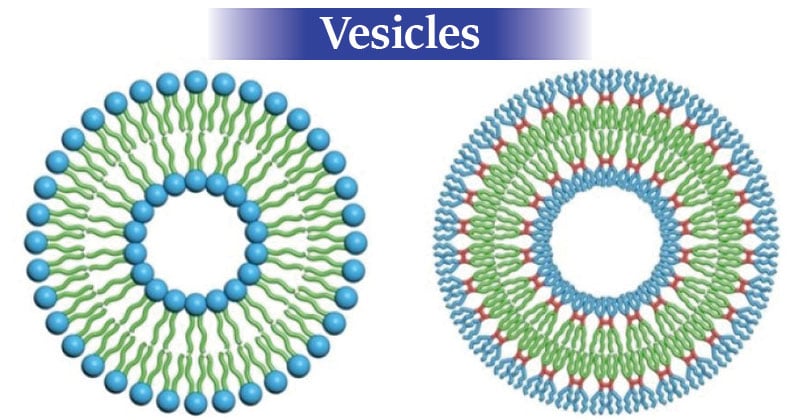Interesting Science Videos
Vesicles Definition
- Cells must be able to move molecules, digest particles, and secrete materials in order to survive. For many cellular functions, vesicles are used.
- It is a small, spherical compartment that is separated from the cytosol by at least one lipid bilayer.
- Many vesicles are made in the Golgi apparatus and the endoplasmic reticulum or are made from parts of the cell membrane by endocytosis.
- Because vesicles are made of phospholipids, they can break off of and fuse with other membranous material. This allows them to serve as small transport containers, moving substances around the cell and to the cell membrane.
- Examples of vesicles include secretory vesicles, transport vesicles, synaptic vesicles, lysosomes etc.
Structure of vesicle

Figure: Diagram of Vesicles
A liposome (left) and dendrimersome. The blue parts of their molecules are hydrophilic, the green parts are hydrophobic.
Credit: Image courtesy of University of Pennsylvania
A vesicle is a small structure within a cell, consisting of fluid enclosed by a lipid bilayer. The membrane enclosing the vesicle is also a lamellar phase, similar to that of the plasma membrane. The space inside the vesicle can be chemically different from the cytosol. It is within the vesicles that the cell can perform various metabolic activities, as well as transport and store molecules.
Types of Vesicles
- Secretory vesicles contain materials that are to be excreted from the cell, such as wastes or hormones. Secretory vesicles include synaptic vesicles and vesicles in endocrine tissues.
- Transport vesicles move molecules within the cells. All cells make proteins and require them to function. Proteins are made in ribosomes. When the proteins are made, they are packaged into transport vesicles and moved to the Golgi apparatus where they can be modified and sorted before being sent to the final destination of the cell.
- Vacuoles are vesicles that contain mostly water. Plant cells have a large central vacuole in the center of the cell that is used for osmotic control and nutrient storage. Contractile vacuoles are found in certain protists, especially those in Phylum Ciliophora. These vacuoles take water from the cytoplasm and excrete it from the cell to avoid bursting due to osmotic pressure.
- Lysosomes are cellular vesicles that contain digestive enzymes. Lysosomes are used by cells to break down food particles and to get rid of unneeded cellular materials.
- Peroxisomes are vesicles that use oxygen to break down toxic substances in the cell. Unlike lysosomes, which are formed by the Golgi apparatus, peroxisomes self-replicate by growing bigger and then dividing. They are common in liver and kidney cells that break down harmful substances. Peroxisomes are named for the hydrogen peroxide (H2O2) that is produced when they break down organic compounds. Hydrogen peroxide is toxic, and in turn, is broken down into water (H2O) and oxygen (O2) molecules.
Functions of Vesicles
- Vesicles store and transport materials with the cell. Some of these materials are transported to other organelles; other materials are secreted from the cell. Most vesicles are involved in transporting some sort of molecules, such as a hormone or neurotransmitter.
- Transport vesicles play a central role in the traffic of molecules between different membrane-enclosed compartments of the secretory pathway.
- Since vesicles are composed of a lipid bilayer, they can have a completely self-contained environment that is different from the inside of the cell. Thus, vesicles also function in metabolism and enzyme storage.
- It is involved in buoyancy control and temporary storage of food and enzymes.
- They can also act as chemical reaction chambers.
- The vacuoles are responsible for isolating materials from the cell, which may be harmful to it and also, contain waste products within themselves. As an autophagic vesicle, the function of this cell organelle is to ingest and destruct any invading bacteria. It is also responsible for maintaining the turgor pressure and the pH value of the cell.
- Lysosomes are specialized organelles that contain digestive enzymes that are used to break down substances in the cell into smaller molecules.
References
- Verma, P. S., & Agrawal, V. K. (2006). Cell Biology, Genetics, Molecular Biology, Evolution & Ecology (1 ed.). S .Chand and company Ltd.
- Alberts, B. (2004). Essential cell biology. New York, NY: Garland Science Pub.
- Kar,D.K. and halder,S. (2015). Cell biology genetics and molecular biology.kolkata, New central book agency
- https://www.ncbi.nlm.nih.gov/books/NBK9886
- Alberts, Bruce, Johnson, Alexander, Lewis, Julian, Raff, Martin, Roberts, Keith, and Walter, Peter (2008). Molecular Biology of the Cell (Fifth Edition), (Garland Science, New York), p. 789
- https://www.ck12.org/biology/Vesicles-and-Vacuoles/lesson/Vesicles-and-Vacuoles-Advanced-BIO-ADV/
- https://study.com/academy/lesson/vesicles-definition-function-quiz.html
